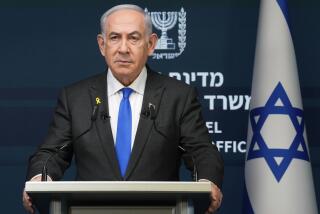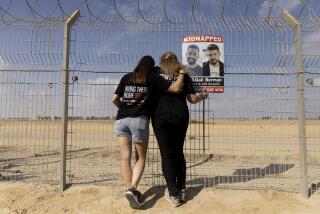Small Steps in Mideast Skirt the Larger Issues
JERUSALEM -- To longtime observers of the Middle East, the latest steps toward resolving the Israeli-Palestinian conflict must seem like deja vu: another peace plan floated, negotiated, violated. Cease-fires are agreed to, broken, discarded, with a steadily rising body count providing the only sustained momentum.
What makes this effort, the so-called road map to peace embraced by President Bush, any different? Does it have a chance to succeed where so many attempts have failed?
It is difficult to find much optimism here. But dramatic changes in the region and important shifts in the internal dynamics of the conflict have opened possibilities that people on both sides cite as reasons that negotiations have endured despite continuing violence.
Late Sunday, Israeli troops began withdrawing from the Gaza Strip following the declaration of a temporary cease-fire by armed Palestinian factions; security cooperation between Israelis and Palestinians is being launched for the first time in two years. But this is the short term, the first steps in a long process. The larger issues that divide the enemies in this war are not being touched, much less solved. A single attack by a gunman or bomber can scuttle everything.
Bush’s recent interest in the problem is a key new element, and both sides rely substantially on Washington’s ability to advance a cease-fire and an eventual political settlement. While politicians here praise Bush’s intense attention, many wonder how long it will last, and whether it will extend beyond next year’s U.S. election campaign.
Israelis and Palestinians -- both peoples proud of their reservoirs of perseverance and resilience -- have suffered enormously in the last 33 months. Both have seen their economies damaged, their psyches battered, their futures darkened. About 3,000 people have been killed, roughly three-quarters of them Palestinians.
The Palestinians, especially, are in dire straits. Their society has regressed a generation, with masses of people now living below the poverty line. The credibility of their leaders on the world stage is in ruins.
In the fall of 2000, after the intifada, or uprising, was launched and stone-throwing youths and armed militiamen battled Israel’s tanks and helicopters, few Palestinians imagined how completely their world would turn upside-down. Retaliation was harsh, and it escalated as Palestinians resorted to suicide bombings -- more than 90 in 2 1/2 years -- that killed hundreds. Israel reoccupied most of the West Bank and Gaza Strip and erected strangling checkpoints at every turn. Today it is building a thick, winding wall that is fencing off Palestinians in an ever-shrinking territory.
The offer of an independent state in the year 2005, as the road map stipulates, has great appeal. Even though most Palestinians remain skeptical it will happen, many are exhausted and willing to suspend the intifada to give the plan a chance.
“Palestinians don’t want to surrender,” said Ali Jirbawi, a political scientist at Birzeit University in the West Bank. “If there’s any hope at all, they are willing to give it a chance.”
Israeli Prime Minister Ariel Sharon, meanwhile, is in a position of strength. Israel is also keen to end the violence that has terrorized its people, and Sharon himself has publicly acknowledged for the first time the corrosive effect that occupation has on the occupier.
Enjoying the strong support of the Bush administration, Sharon can cooperate with American mediators fully confident that he will not be pressed into concessions he can’t stomach.
“So far, there is not a lot of daylight between American and Israeli positions,” said Mark Heller, a researcher at the Jaffee Center for Strategic Studies in Tel Aviv. “Basically, this American administration has internalized the idea that in the last decade the major obstacles [to peace] have come from the Palestinian side.”
Several analysts here also point to transformations in the Middle East following the U.S. war in Iraq. The dominance of the U.S. force, the fall of Saddam Hussein and U.S. threats against other regimes robbed the Palestinians of allies in the Arab world, these analysts say. The Palestinians saw themselves being tarred with the same brush as Hussein, his loyalists and major terrorist organizations. The fall of Hussein also meant a considerable loss of money for the Palestinians.
“From the moment Saddam’s statue was torn down and U.S. authority was asserted in a very impressive way, Sharon started moving,” said Eran Lehrman, a former Israeli intelligence officer who heads the American Jewish Congress in Jerusalem.
Sharon, his government and the Israeli military saw an opportunity to bring the Palestinians to terms, said Lehrman.
It was shortly after the fall of Baghdad that a sidelined Yasser Arafat was forced to accept the appointment of a prime minister, Mahmoud Abbas, considered a relative moderate, and a new government that included the widely respected Salam Fayyad as finance minister. The Israelis and the Americans want to work with both men.
Palestinians, meanwhile, stress that an important difference in today’s push-pull is the evident cooperation of the radical Islamic Hamas movement, which is responsible for scores of attacks on Israeli civilians and stands for the destruction of the Jewish state.
Though the move is dismissed by Israelis as a ruse, Hamas has agreed to a temporary cease-fire. The largest and most popular of Palestinian factions, Hamas is under great pressure -- from the Israeli army’s relentless hunt-and-kill campaign targeting militant leaders, from European threats to ostracize it and from the Palestinian Authority itself. Washington has declared Hamas a terrorist organization, and much of its funding has been cut off.
Hamas is showing pragmatism, keenly aware of the mood on the Palestinian street and dedicated to self-preservation.
“Hamas does not want to be seen as the spoiler,” said Jirbawi, the Birzeit analyst. “They don’t believe in the road map and don’t think it will work, but they don’t want to be pointed at in the future as the ones who ruined it.”
So they will go along with Palestinian Authority entreaties to preserve unity, avoid the civil-war scenario that Palestinians fear and halt attacks, for now. The desire is to put the onus on Sharon, who the Palestinians believe will not hold fire for long.
Abbas has assured Hamas leaders there is a role for them in a future, democratic Palestinian state, Palestinian sources said. It seems clear that Abbas and Palestinian security chief Mohammed Dahlan will not attempt to dismantle Hamas but co-opt or buy it off where possible, analysts say.
Saeb Erekat, at one time the Palestinians’ chief negotiator and a veteran of many peace efforts, said the truce by Hamas and Islamic Jihad was a “ray of hope” that had been missing for 33 months.
“We have a moment of truth, a good opportunity,” he said, speaking before Sunday’s final truce announcements. “We can say it’s insignificant and go to civil war so Sharon can be satisfied -- or we can say it’s significant, and the Americans can get their acts together.”
More than a dozen cease-fires have been declared since the intifada erupted, but none has lasted. This is the first to be coordinated by the three principal armed factions.
Mistrust and deep conviction of the enemy’s ill will seem to be the driving forces at this fragile stage. Neither side believes the other will hold up its end of the bargain. At the end of the day, Israelis do not believe Palestinians will round up terrorists. Palestinians do not believe Israelis will stop settlers who are grabbing land by the day. Each is waiting for the other to violate the rules and accords first.
Suspicion, or at least questions, extend to Washington’s role as well.
“When does the American interest fade?” asked Jirbawi. “What is the goal of the American intervention? To get truce and relative calm and to go back to managing a low-intensity conflict? Or is it actually an intervention to solve the whole issue? We’ll have to see.”
Megan K. Stack in Beit Hanoun, Gaza Strip, contributed to this report.
More to Read
Sign up for Essential California
The most important California stories and recommendations in your inbox every morning.
You may occasionally receive promotional content from the Los Angeles Times.











